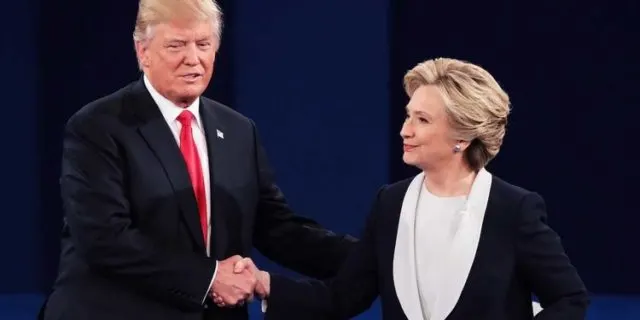| Donald Trump: | Hillary Clinton: | Toss Up: |
2016 Election Results
Businessman Donald Trump (R) defeated former New York Senator and Secretary of State Hillary Clinton (D) for the presidency on November 8, 2016.
Trump received 304 electoral votes to Clinton’s 227 electoral votes. Clinton won the national popular vote with 48.2% of the vote, while Trump received 46.1% of the vote. Clinton and Trump criticized each other over character issues and shared divergent views on America’s role in the world.
The map above shows Trump winning 306 electoral votes because that’s what would have happened if two Texas electors hadn’t voted against him.
The 2016 electoral map is above. Click on the states in the map to toggle them between Democrat, Republican and Tossup.
Primaries
President Barack Obama (D) was unable to seek re-election due to term limits. Clinton was seen as the frontrunner when she announced her campaign in 2015. Her path to the nomination was blocked initially by Vermont Senator Bernie Sanders, an independent who aligned with Democrats. Despite Clinton’s support from Democratic leadership, Sanders stayed in the race through June 2016 with grassroots organizing and significant support from individual donors. Clinton clinched the nomination and selected Virginia Senator Tim Kaine as her running mate.
A crowded field for the Republican nomination provided a path for Trump, who never sought nor held public office. Trump’s platform of restricting immigration, ending free trade agreements, and more aggressive policy toward international foes allowed him to bypass established candidates like Florida Governor Jeb Bush, Florida Senator Marco Rubio, and Texas Senator Ted Cruz. Trump secured enough delegates for the nomination following the May 3 primaries and selected Indiana Governor Mike Pence as his running mate.
Central Issues
The Pew Research Center found that the economy (84% of respondents), terrorism (80%) and foreign policy (75%) were the top three issues on voters’ minds in 2016. Trump appealed to conservative and independent voters by advocating tax cuts on all income levels. He supported import tariffs instead of free trade agreements, which he criticized as responsible for job losses. Clinton supported tax increases for high-income earners and the elimination of tax credits for companies exporting jobs aboard.
Clinton leaned on her experience as a U.S. senator and secretary of state in response to voter concerns about terrorism. She supported increased screening of visa applicants from countries controlled by the Islamic State and use of military force against ISIS. Trump supported more strenuous review of Muslim entrants to the country, a re-evaluation of NATO participation, and increased military spending. Clinton supported the Obama administration’s 2015 nuclear limitation deal with Iran, while Trump strongly opposed the deal.
A vacant seat on the U.S. Supreme Court also attracted interest from liberal and conservative activists. Justice Antonin Scalia’s death on February 13, 2016, led Obama to nominate Merrick Garland for the seat on March 16, 2016. Clinton argued for the U.S. Senate to hold confirmation hearings for Garland rather than wait for the results of the presidential election. Trump supported keeping the seat open until the election was resolved and released a list of prospective nominees in September 2016.
Strategy
The Clinton and Trump campaigns focused their resources on discrediting each other as credible presidential candidates. The Clinton campaign highlighted Trump’s financial dealings, refusal to release tax returns, and bankruptcies as indicators of questionable behavior. Trump was also criticized by Democratic surrogates for derogatory comments about women, minorities, and immigrants.

Trump and Republican surrogates attempted to connect Clinton with her husband’s impeachment and political maneuverings. Clinton was criticized for referring to half of Trump’s supporters as deplorables. Trump also pointed to her use of a private email server during her time as secretary of state as a sign of her untrustworthiness.
2016 Election Results
Trump’s victory in 2016 relied on victories among white and independent voters. Trump received 57% of the vote among all white voters to Clinton’s 37%. He defeated Clinton among independents by a four-point margin. Clinton won 53% of voters who earned less than $50,000 per year, while Trump narrowly won votes among voters earning more than $50,000.
These demographic victories translated into Republican inroads into the Upper Midwest and the Northeast. Trump won Michigan, Wisconsin, and Pennsylvania by less than 1% of the vote in each state. The 2016 election represented the fourth time that the popular vote winner did not win the Electoral College, joining elections in 1876, 1888, and 2000.
The negative tone of the 2016 presidential election led to the highest third-party vote total since 1996. Former New Mexico Governor Gary Johnson left the Republican Party for the Libertarian Party nomination. Johnson received 3.2% of the popular vote, while Green Party candidate Jill Stein received 1.07% of the vote. In Michigan, Wisconsin, and Pennsylvania, the Johnson and Stein vote totals exceeded the margins of victory for Trump.
